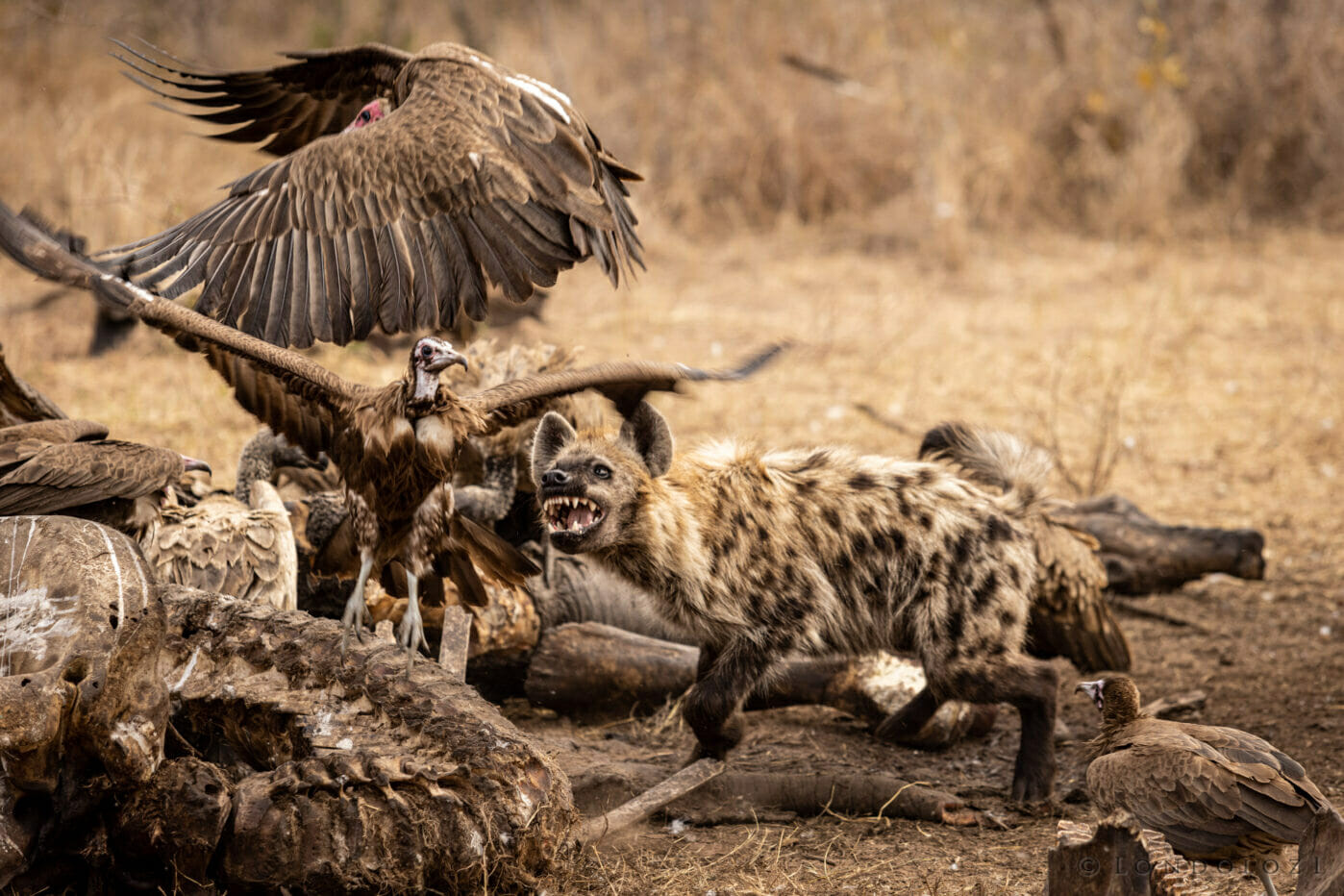When we think of a visit to Londolozi, our minds often jump to the apex predators of the bush. The powerful lions, elusive leopards or the tireless wild dogs, but behind the scenes, there is another group of animals that play a critical role in balancing the ecosystem, the scavengers. Often misunderstood and overlooked, nature’s clean-up crew ensure that nothing goes to waste and do so in fierce competition with each other. So let’s discuss the competition and hierarchy amongst this group of animals and the importance of their role out here in the bush.

Usually at big carcasses, hyena and vultures will tolerate each other (to an extent), but when food is limited, a fierce battle can ensue
Who makes up the clean-up crew?
The scavengers of the African bush are a diverse group, each with their own role, but the following list includes the primary members.
- Vultures – vultures are the ultimate aerial scouts. Their keen eyesight can spot carcasses from a great distance away. It is believed they can spot a 6cm long object from up to 1km above the ground, meaning their eyesight is at least 8 times better than ours.
- Hyenas – often mistaken for mere scavengers but are also highly efficient hunters as well. But being opportunistic, they often use their brute strength to steal kills from other predators and feed on what is left behind.
- Jackals – small and resourceful, jackals use their speed and cunningness to dart in and grab scraps where they can. They will even trail behind larger predators, waiting for an opportunity to feed.
- Marabou storks and eagles – this group of scavengers are often the last at a kill and feed on any scraps left behind from the other scavengers. Being more timid in nature they wait all the way to the end of the chaos to get what they can.
Competition and hierarchy: who eats first
Despite their shared goal of finding food, scavengers are in constant competition with each other. A strict hierarchy will often dictate who eats first when a carcass is found.
- The early detectors, Vultures – once a carcass is located by soaring vultures, they will begin to circle and descend towards it, drawing in others from kilometres away. This will often signal to other scavengers that there is food in the area and draws them in as well. In this case, they will have to wait their turn as larger and more dominant scavengers take priority and feed first.
- The muscle, Hyenas – upon arrival of these bigger and more dominant scavengers, they will drive away vultures and smaller scavengers. Using their immense power and strong jaws, they will chew bones and expose nutrients other scavengers cannot reach.
- The opportunists, Jackals – Jackals are more than often left with the scraps, forced to navigate around the larger scavengers while snatching whatever morsels they can find.
- The final clean up, Marabou Storks and Eagles – once the larger animals have had their fill, Marabou Storks and other eagles such as Tawny Eagles and Bataleurs move in to pick the remaining bits from the carcass, ensuring that every little bit does not go to waste.
The Importance of Scavengers
Without scavengers, the bush would be a very different place. Their role goes far beyond simply consuming carrion; they help prevent the spread of disease, recycle nutrients back into the ecosystem, and maintain a balanced food web.
Vultures, in particular, are crucial in stopping the spread of disease. Their stomachs contain incredibly strong acids capable of neutralising dangerous pathogens such as anthrax and rabies. Without them, rotting carcasses could become breeding grounds for disease, posing a threat to other wildlife and even humans.

Although vultures are often overpowered by the larger scavengers, their sheer numbers can be intimidating enough to hold a kill for themselves.
Hyenas, despite their sometimes fearsome reputation, also contribute significantly to the ecosystem by breaking down tough bones that would otherwise take much longer to decompose. Even jackals and marabou storks play a role in ensuring that nothing is left behind.
While scavengers may not receive the same admiration as big cats or elephants, their importance in the ecosystem is undeniable. They are nature’s recyclers, preventing waste and disease while competing in a never-ending battle for survival.
Next time you see vultures circling overhead or a hyena loping across the plains, take a moment to appreciate the clean-up crew—without them, the African wilderness would be a far messier place.


















Is there a pecking order (no pun intended!) among the various vulture species? And what about skin/hide? Having once seen an elephant carcass, all the scavengers seemed to avoid the hide. Does it just rot in place?
Thanks Bryce for this great blog on scavengers, the clean-up crew of the bush, which is so essential for the well-being of all other animals and all humans. One doesn’t want to imagine the consequences if this crew or crews wouldn’t be there anymore. There would indeed be dire consequences for all life in the bush.
Great photos
The vultures definitely are the vacum cleaners of the bush and they do good work keeping the bush clean from rotting meat and diseases. The hyenas are also there to help clean up and the jackals as well. The vultures eyesight is incredible and the hyenas are opportune animals stealing everyone’s kill.
Thanks for this fascinating blog on “clean up crew” and their many positive impacts Bryce!
Beautifully written, easy to comprehend and follow along. Definitely using as a reference for my upcoming Year 12 task.